Even though most owls are nocturnal hunters and we can’t see what they hunt, we know a surprising amount of information about their diet. An owl’s feces look like any other bird dropping, so we can’t tell what they eat. The clues to an owl’s diet lay in owl pellets–regurgitated pellets of indigestible material such as bones, fur, fish scales and teeth–because owls swallow their prey whole.
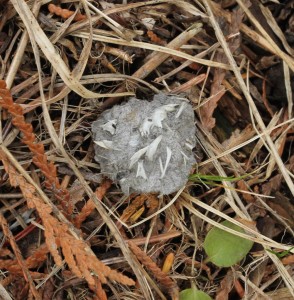
An owl pellet exposed to the weather deteriorates over time exposing the contents, such as the small skull in this owl pellet.
When the pellets are first regurgitated, they are shiny and black. As the pellets dry out they turn gray. Owl pellets can be tightly compacted, oval and furry or loosely compacted and irregular shaped.
The contents of each pellet depend on the diet of the owl. Flammulated owls eat almost exclusively insects so their pellets contain exoskeletons of insects. Pygmy owls eat moths, beetles, grasshoppers, birds and bats so their pellets are a mixture of fur, teeth, skulls, claws, feathers, bones and exoskeletons.
When an owl swallows prey, it swallows the prey whole. Owls don’t have a crop like many other birds to store food after it has been swallowed and before it can be digested. Instead, the prey goes directly to the owl’s two-chambered stomach.
An owl’s stomach consists of the proventriculus and the ventriculus, also known as the gizzard. The proventriculus produces enzymes, acids and mucus that digests the muscle, fat, skin and internal organs of the prey much like our stomach.
Indigestible material is left in the gizzard since the stomach juices are too weak to digest the material and it is too dangerous to pass through the intestines if not completely digested.
When the gizzard is full of indigestible material, it compresses all of the material into a compact pellet. If an owl eats several small items of prey over several hours, all of the indigestible material is compacted into one pellet.
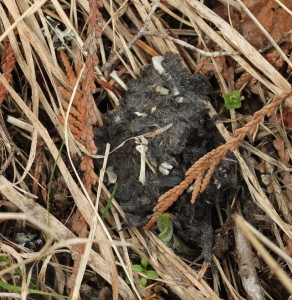
Regurgitated owl pellets provide food and shelter for various larvae, insects, and fungi since many insects eat fur and feathers.
The action of compressing the pellet takes a few hours. The compressed pellet is slimy and wet when finished and is moved back to the proventriculus. Owls can store the pellet for up to 20 hours in the proventriculus.
Since the pellet partially blocks the entrance to the digestive system, the owl must eject the pellet before eating again.
When an owl is ready to regurgitate the pellet, the owl closes it eyes and looks like it is coughing. The pellet readily comes out when the beak is opened much like when we vomit when we’re sick.
Regurgitating doesn’t hurt the owl because the pellet is still slimy and wet when in the owl’s body. Once ejected the pellet quickly dries out and begins to decompose.
Pellets can only be as large as the owl’s gizzard. Great horned owl pellets can be up to five inches long while northern saw-whet owl pellets are approximately one inch long.
The pellets are typically found under an owl’s daytime roost and if it has a regular roost, then a pile of pellets can be found.
Close inspection or dissection of the pellet reveals what the owl ate recently since one to two pellets are typically regurgitated each day. Usually the bones aren’t broken during the entire process, so skulls and jawbones help identify the prey consumed.
These tiny bundles of fur, bones and other indigestible material provide clues to an owl’s diet and hunting habits even when we don’t see the owl.

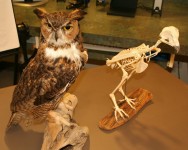
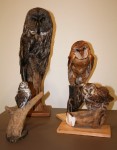

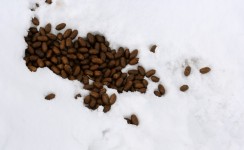
Just wonderful.
Oh, to be a kid in one of those classes
I missed my calling!